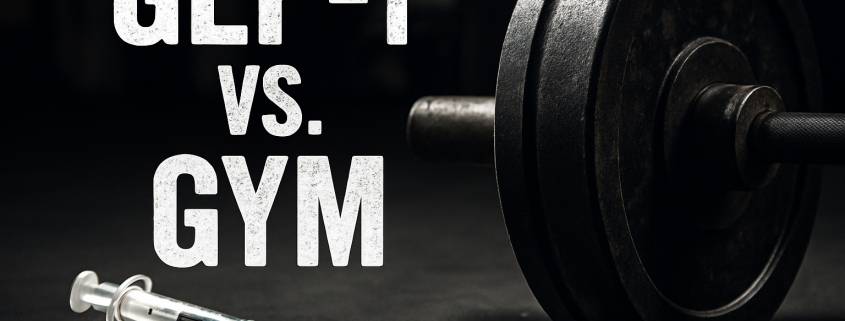GLP-1 Weight Loss Drugs vs. Exercise: What You Need to Know Before You Choose
If you’ve been paying attention to health headlines, you’ve probably heard about the surge of GLP-1 weight loss medications like Ozempic, Wegovy, Mounjaro, and Zepbound. These drugs are everywhere, promising fast results and dramatic transformations.
At the same time, the old-school method of exercise and strength training has never left. While it may not grab as many headlines, decades of research — and thousands of transformations here at CrossFit Sweat Shop in Walnut Creek — prove its effectiveness.
So, what’s the real difference between GLP-1 medications and exercise when it comes to weight loss, body composition, and long-term health? And if you’re considering one of these drugs, how can you make sure you’re not sacrificing muscle, strength, and energy in the process?
Let’s break it down.
How Much Weight Do You Really Lose?
GLP-1 medications (like semaglutide and tirzepatide) can deliver major scale results.
-
Clinical trials: 15–21% of body weight lost over a year. That’s 30–40 pounds for someone starting at 200 pounds.
-
Real world results: Often lower, averaging 9–12%, as people may take smaller doses, stop early, or struggle with side effects.
Exercise alone, especially when done without structured programming, leads to more modest weight loss: 3–7% of body weight. But here’s the catch:
Even when the scale doesn’t change much, exercise consistently reduces body fat percentage, trims waistlines, and improves health markers like blood pressure, blood sugar, and cholesterol.
👉 Takeaway: GLP-1s are unmatched for sheer weight loss on the scale. Exercise is unmatched for improving health across the board.
What Kind of Weight Comes Off?
Here’s where things get tricky.
-
On GLP-1s: You lose fat, yes — but you also lose muscle. Research shows that up to 25–30% of total weight lost on GLP-1 drugs is muscle mass. Without resistance training and enough protein, this leaves people smaller but weaker, with slower metabolisms.
-
With exercise: Resistance training not only preserves muscle, it can actually build it, even as fat comes off. This protects metabolism, supports strength, and prevents the “deflated” look.
This is why pairing GLP-1s with strength training 2–3 times per week and adequate protein intake is essential. Otherwise, you may end up trading one problem (excess weight) for another (muscle loss and fragility).
Beyond the Scale: Health Benefits
Weight loss is only part of the picture. Here’s how the two approaches compare:
Heart Health
-
GLP-1s: Semaglutide reduced heart attack, stroke, and cardiovascular death risk by about 20% in high-risk patients.
-
Exercise: Decades of research prove exercise lowers blood pressure, improves cholesterol, reduces resting heart rate, and cuts the risk of death from all causes.
Bone Health
-
GLP-1s: Rapid weight loss from drugs or diets can weaken bones.
-
Exercise: Strength training helps preserve and even increase bone density.
Mood & Energy
-
GLP-1s: Can improve self-image as weight drops, but no direct mood benefits.
-
Exercise: Acts as a natural antidepressant and anxiety reducer, improves sleep, boosts daily energy.
👉 Bottom line: Exercise improves nearly every marker of health — even when the scale barely moves.
Loose Skin: A Common Concern
Loose skin isn’t about how you lose weight, but how much and how fast.
-
Rapid, dramatic losses (whether from surgery, drugs, or crash diets) increase the risk.
-
Genetics, age, and years spent overweight also play a role.
-
Exercise can help improve muscle tone, skin thickness, and overall appearance — but it won’t erase major folds.
If you’re on GLP-1s, combining them with strength training is the best way to minimize the “deflated” look.
Risks and Realities
GLP-1 Drugs
-
Common side effects: Nausea, vomiting, digestive discomfort.
-
Serious but rare risks: Gallbladder issues, pancreatitis.
-
Cost: $1,000+ per month if not covered by insurance.
-
Maintenance: Many regain weight after stopping.
Exercise
-
Risks: Overuse injuries if you go too hard too soon.
-
Rewards: Virtually limitless — improved energy, strength, resilience, longevity.
-
Cost: Gym membership, shoes, or basic equipment — far less than monthly medications.
👉 Exercise isn’t just cheaper — it pays dividends in areas no drug can touch.
Practical Advice (Whether You Use GLP-1s or Not)
If you’re on a GLP-1 drug:
-
Lift weights 2–3 times per week. Focus on big movements like squats, presses, and deadlifts.
-
Eat protein with every meal. Aim for 25–40g to support muscle.
-
Add cardio smartly. Think running, biking, rowing — but balance it with strength work.
-
Hydrate and sleep. At least 7–8 hours per night.
If you’re not on a GLP-1 drug:
-
Strength training + conditioning is still king. The combination burns fat, builds muscle, and protects long-term health.
-
Set a “floor and ceiling” for movement. Even on your worst days, do something simple (push-ups, squats, sit-ups). On your best days, aim for a full workout.
The CrossFit Difference
 Not all exercise programs are created equal.
Not all exercise programs are created equal.
Many people stick to walking or basic cardio, which has benefits — but falls short on preserving muscle. Others dabble in strength training without enough consistency or progression.
At CrossFit Sweat Shop in Walnut Creek, we blend both: progressive strength training + conditioning. This formula is the gold standard for protecting muscle, boosting metabolism, and improving heart health — whether you’re on a GLP-1 drug or not.
It’s the exact combination most people are missing.
Final Takeaway
GLP-1 drugs like Ozempic, Wegovy, Mounjaro, and Zepbound are powerful tools for weight loss. But they are not magic bullets.
-
They can help drop scale weight fast — but at the cost of muscle, bone strength, and long-term resilience if not paired with the right exercise.
-
Exercise, especially strength training, delivers benefits no injection can replicate: strength, confidence, mood, energy, bone health, and longevity.
👉 If weight loss is your goal, exercise should always be the foundation. And if you choose to use a GLP-1, combining it with strength training is non-negotiable if you want to stay strong, healthy, and happy with the results.








Leave a Reply
Want to join the discussion?Feel free to contribute!